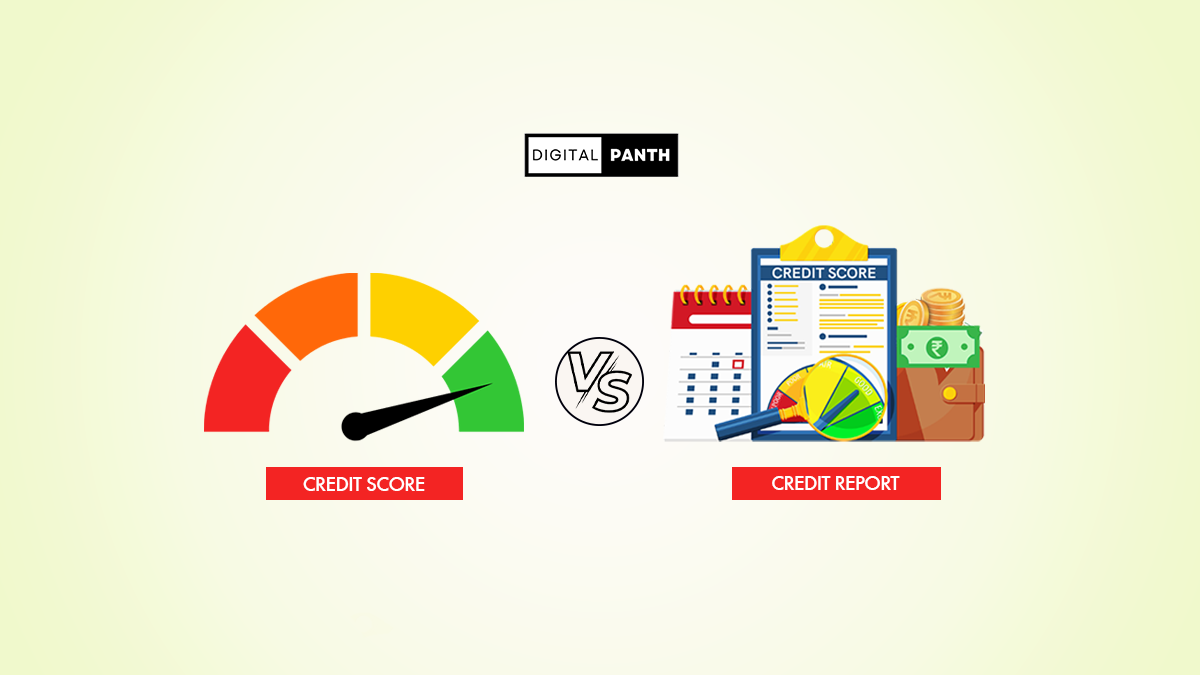Credit score and credit report are both essential tools that lenders use to evaluate your financial behaviour, but they serve different purposes.
A credit score is a three-digit number that reflects your creditworthiness, while a credit report is a comprehensive document that outlines your borrowing and repayment history in detail.
Each element plays a distinct role during loan approvals, interest rate decisions, and credit card evaluations. Credit bureaus like CIBIL, Experian, and Equifax generate and provide credit information to lenders based on your financial activity.
Understanding this difference can help you track your credit health more effectively and improve your chances of getting better loan offers from Indian lenders.
What is a Credit Score?
A credit score is a three-digit numerical usually ranging between 300 to 900 that shows the numerical representation of your credit history. Credit score basically shows how trustworthy you are with borrowed money.
Your score is generated by RBI-licensed credit bureaus, including CIBIL (TransUnion CIBIL) and Experian India, using your borrowing and repayment data.
Various key factors that influence your credit score in India.
Credit bureaus use your financial history to calculate your score. These are the primary components:
- Repayment history
- Credit utilization
- Credit mix
- Age of credit history
- Recent enquiries
Score Ranges
| Score Range | Rating | Implication |
| 800 – 900 | Excellent | Quick approvals, lowest interest rates, best credit limits |
| 750 – 799 | Good | Eligible for most credit products at decent rates |
| 700 – 749 | Fair | May get approved, but with slightly higher interest |
| 650 – 699 | Low | Limited credit access, higher interest, more scrutiny |
| Below 650 | Poor | Loan applications likely to be rejected |
If you’re wondering where to check your credit score, there are several options:
- CIBIL: www.cibil.com – One free credit report every year
- Experian India: www.experian.in – Also provides one free credit report
- Apps like OneScore, Paytm, and BankBazaar: Helpful for quick checks, though they may use simplified scoring models
What is a Credit Report?
A credit report is a detailed document of your credit history prepared by a credit bureau. Credit report is created when you borrow money or apply for credit for the first time.
Credit report contains the following key sections:
| Section | What It Includes | Why It Matters |
| Personal Details | Full Name Date of Birth PAN Contact Numbers Email Current & Past Addresses | Helps lenders verify your identity and match your credit profile accurately |
| Account Summary | List of all credit accountsLoan typesLendersSanctioned amountCredit limitsAccount status | Gives an overview of your active and closed accounts, along with limits and balances |
| Repayment History | Month-wise EMI/card paymentsDays Past Due (DPD)Any missed or delayed payments | Crucial for evaluating repayment discipline — directly impacts your credit score |
| Credit Enquiries | Record of lenders who’ve pulled your credit report recently, along with date and purpose of enquiry | Too many recent enquiries may indicate credit-hungry behaviour |
| Remarks or Flags | Settled/Written-Off tagsLoan restructuring infoSuits Filed/Wilful DefaultDRT references | Red flags that may hurt your approval chances even if your score is high |
Your credit report retains financial activity data for up to 7–10 years, even after a loan is closed. RBI mandates that each individual is eligible for one free credit report per bureau per year. Discrepancies in the report can be corrected by raising a dispute request through the bureau’s portal.
Credit Score vs Credit Report: Summary.
| Aspect | Credit Score | Credit Report |
| What it is | A 3-digit number (300 (Poor) to 900 (Excellent)) that represents your creditworthiness | A record of your credit history and activities describing your credit based behaviours. |
| Purpose | Lenders use to quickly summarize the risk of lending. | Lenders use to evaluate a potential borrower’s total credit profile. |
| Format | Numerical only | Text + tabular format (accounts, payments, enquires) |
| Data used | Derived from the credit report. | Data provided directly by lenders (accounts, payments, defaults). |
| Updated | Monthly, approximately. | Monthly, or any time lenders provide new data. |
| How lenders use it | First level screening for lending eligibility. | Final evaluation of credit behaviours and risks, if credit score jumps type exercised. |
| Access | Apps, Fintechs, bureau websites. | 1 free report per year from each bureau (mandated monthly from the RBI). |
| Is it disputed? | No, the credit score can only change when your data changes. | Yes, a user can dispute via a bureau portal incorrect accounts told to exist. |
| Impact on approval | Higher credit score = better eligibility for loans/credit cards and lower interest rate. | A borrower with negative remarks can have their loan/request rejected even with a very good credit score. |
Conclusion.
In conclusion, both your credit report and credit score are essential parts of your financial identity. Review both formats regularly, across a few bureaus to help ensure you catch mistakes quicker and will help with better loan approvals down the line.
Disclaimer:
This article is not financial advice. It is intended for informational purposes. Credit policies and scoring models vary by institution. Readers should seek guidance from a financial advisor or credit bureau for advice that is more personal to their situation.
FAQ`S.
When you check your own credit report, your credit score will not be affected at all. But if a lender checks your credit report to give a loan or credit card, this could have a small impact on your score.
Yes. You can have many different credit scores because each credit bureau (CIBIL, Experian, Equifax, CRIF High Mark) uses its own scoring model.
While your credit report may not show any significant issues, you may have a low score due directly to other factors such as a high amount of credit utilization, too many recent loan applications, or simply a short that does not give you enough credit history. There could be subtle things in your report that may negatively affect the score.

